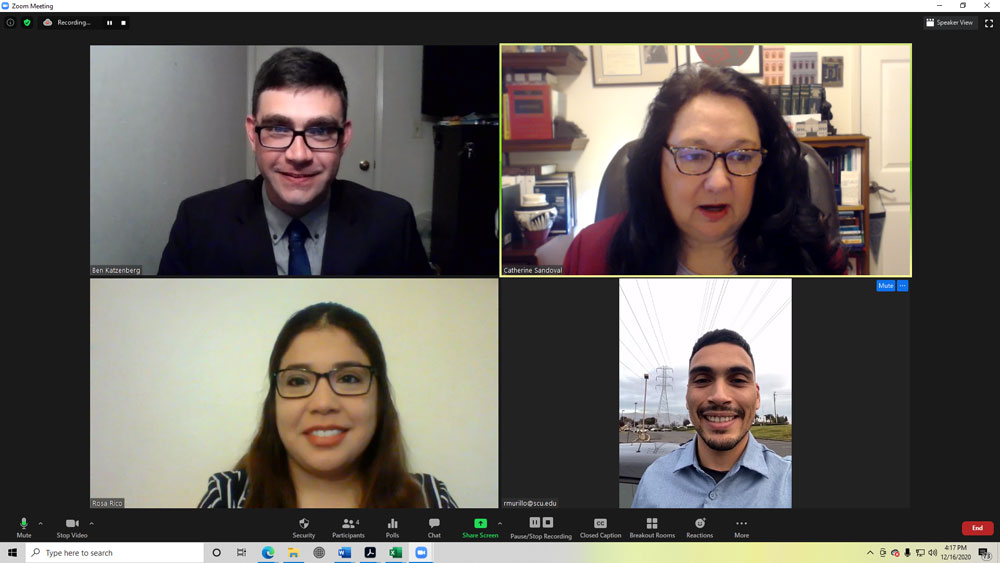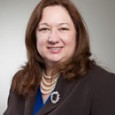By Deborah Lohse
With devastating, record-smashing wildfires across California in recent years—many caused by aging or failing power lines and facilities—you’d think there would be an army of watchdogs clamoring to ensure that the state’s largest utility was doing all it can to upgrade equipment and utilize all possible tools for safety.
In fact, there are precious few knowledgeable advocates doing so. But among those few are a small but mighty band from Santa Clara Law: Professors Catherine Sandoval and Allen S. Hammond IV, students Robert Murillo JD ’21, and Rosa Rico JD ’21, and new alumnus Ben Katzenberg JD ’20.
The group, under the umbrella of the Broadband Institute of California (BBIC) at Santa Clara Law, has been on an unpaid, David vs. Goliath quest to protect millions of Californians from equipment mishaps and operational failures that can cause raging wildfires. They also want to prevent hugely disruptive power shutoffs, which Sandoval argues masks the real problem: failures by utility companies to properly maintain the electric grid.
For the last several years, the group has pursued legal research to rebut key pillars of Pacific Gas & Electric’s (PG&E) delay-and-debate approach to fire safety, including:
- Speaking at workshops and hearings;
- Filing comments, such as Sandoval’s successful comments on PG&E’s Wildfire Safety Mitigation plan, which helped the California Public Utilities Commission (CPUC) push PG&E to analyze and report on what’s causing the company’s exceptionally high level of electric wire failure;
- Researching ways to avoid power shutoffs that PG&E insists are necessary to avoid electricity-caused fires; and
- Advocating for innovative risk-detection tools including a crowd-sourcing photo app and artificial intelligence.

The BBIC team includes: top row from left: Ben Katzenberg and Professor Catherine Sandoval; and bottom row from left: Rosa Rico JD ’22 and Robert Murillo.
Professor Al Hammond, also a team member, is not pictured.
App Success
The group on Oct. 8 won a big victory at the CPUC: a requirement that PG&E enact a pilot phone app enabling customers in high-fire-risk areas to send photos of potentially hazardous utility poles and equipment to PG&E. The goal: have the $20 billion company integrate such information into its prevention efforts to identify and repair utility poles with sparking or uninsulated wires; overloaded poles with aging transformers or poorly attached equipment; dry, flammable vegetation dangerously close to wires; or other fire-risky and hazardous conditions.
In fact, about one-third of the language of the Oct. 8 order referenced work done by the BBIC group—resulting in much more stringent requirements for PG&E than the company had originally proposed.
“The problem with utility poles is mostly a problem of detection…having people who inspect them enough” explains Katzenberg. “Anything with technology or with crowdsourcing…might cost money to develop, but if it’s developed properly, it is going to save money.”
So the app would seem like a win-win. But, in fact, it took years of steadfast legal work to get there, with years of legal wrangling and opportunities to build public engagement still ahead.
The Pole Problem
The phone-app effort started a few years ago, when Sandoval was a member of the five-member CPUC (2011-2017) while also a faculty member at Santa Clara Law. She had long heard electric and communications companies complain that monitoring and inspecting their millions of aging poles and infrastructure was costly and onerous. Sandoval became an active advocate for the idea of allowing the public to send in photos of decrepit or faulty equipment via phone apps, including serving as an ideator and judge at several app hackathons.
In 2017, when she was back full-time at Santa Clara Law, she led a tour of risky utility poles in San Jose, which was attended by CPUC President Michael Picker, PG&E, and other utility company representatives, and media including journalists from ABC7, New York Times, and Wall Street Journal. That same day, she spoke at a Public Participation Hearing at the Santa Clara County Board of Supervisors about the need to ensure compliance with CPUC rules governing utility poles and infrastructure to protect public safety and promote reliability.
She brandished photos of obvious CPUC-rule violations: poles using rope, duct tape, and other shoddy materials to attach equipment, or fragments of old pieces of utility poles weighing hundreds of pounds still hanging on poles, even though such “pegs” are supposed to be removed within 60 days. Katzenberg, then a rising 2L, also spoke about the importance of reliable and safe communications and electric services, noting such services were essential to his law studies and to the community.
Then came the record-breaking October 2017 Fire Siege in Sonoma, Napa, Mendocino, and Humboldt counties and the deadly 2018 Camp Fire—which destroyed most of Paradise, California. A June 2019 CPUC order required PG&E to facilitate public submission of photos through an integrated app. PG&E submitted its plan, and the CPUC invited public comments, including two public workshops.
Sandoval and Katzenberg, then her energy law student, attended and spoke at a Feb. 2020 workshop. Sandoval shared photos taken in May 2019 when Santa Clara Law web designer Michelle Waters invited Sandoval to tour her high-fire-prone neighborhood in the Santa Cruz Mountains, where Waters lives with her husband, Peter Golcher JD ’08. Waters had shared with Sandoval the experiences of her neighborhood’s Firewise group, which regularly clears brush and tries to alert PG&E when they spot problematic equipment. In at least one case, PG&E had ignored repeated customer warnings about a sparking wire—and only agreed to fix it when the neighbors called the fire department.
At that workshop it became obvious to the BBIC group that what PG&E had proposed was a shell of what an effective app could and should be. For starters, the company was saying that the public wouldn’t know how to properly or safely take photos, and wouldn’t know what to look for. That struck Rico as preposterous. “They don’t think we know how to take photos?” she said to her professor.
What’s more, PG&E had drastically downscaled the scope and impact of the app from what it had been ordered to create. Instead of being open to all Californians, PG&E was suggesting only a fraction in the highest-risk regions be invited to try the app. Instead of a permanent program of crowdsourcing solutions, PG&E wanted the app to be a six-month pilot, with a siloed department receiving the photos and responding only to the senders—not the public at large. And they had a long list of ways in which the effort could be labeled a failure—including if more than one person sent in a photo of the same risky equipment.
“They set it up to fail,” said Sandoval.
But the group fought back. Katzenberg, then a 3L, asked pointed questions at the Feb. 2020 workshop, such as whether PG&E had considered different metrics that could help the app succeed; how the app would work in rural areas without internet; and whether PG&E was keeping up with the true promise of crowdsourcing these days.
At that point, CPUC safety-division staffers encouraged Sandoval and her students to become a “party” to the app proceeding, a status giving them the right to file motions, request discovery, and file comments. They gladly did so, under the umbrella of BBIC.
The resulting order was much stronger thanks to BBIC. It required a two-year pilot program, open to every Californian in high-risk fire districts; it increased the list of “valid submittals”; and it provided for training for the public. PG&E is required to deploy a working app by August 2021. On the dais after adopting the decision in October, CPUC Commissioner Rechtschaffen thanked the BBIC and Sandoval for their leadership and contributions to the proceeding.
The CPUC “needed somebody who was willing to look at it with fresh eyes,” said Katzenberg, who is now seeking a job in energy law. “To say ‘we think this could make a lot more sense,’ and not come at it from what we think PG&E would be willing to do, but from how it should really happen.”
As parties to the matter, the students and Sandoval undertook research projects to strengthen their case.
Murillo, in addition to drafting some of the comments submitted to the CPUC, began researching the ways PG&E could avoid the disruptive and increasingly frequent power shutoffs that the company insists are necessary in places like Madera County, where he’s from. His paper will be published in the Santa Clara Law Review. He researched the increasing use of artificial intelligence by utility companies to integrate and analyze data, a model that could be applied to the app project.
Rico researched app use by the public, incorporating lessons from Sandoval’s communications-law class on the role of “Administrator Willingness” as a determinant for success.
Waters said she’s proud SCU is empowering the public to find and report faulty equipment—despite PG&E’s claims that the public doesn’t know what to look for. “Yes, to a certain extent, there’s a lot to learn,” said Waters. “But sparking power poles? That seems pretty obvious. Or vegetation wrapped around the pole? That’s pretty obvious, too.”
Although repair would indeed be costly to PG&E, the BBIC team is convinced that with technology and an open mind, solutions can be found.
“The first thing PG&E needs to do is change their minds,” added Sandoval, who began in June 2020 serving as pro bono co-counsel with attorneys representing PG&E customers in a federal criminal probation proceeding related to the 2010 San Bruno Natural Gas explosion. “We’re seeing over and over again where they need to change their operation.”
It will require ongoing diligence by Santa Clara Law and others to make sure that happens. “We owe it to each other to use our voice and whatever power we have to make sure that the public is being taken care of,” said Rico. “We are holding these companies responsible for their actions and hopefully changing the way corporations and boards of directors think about their responsibility to the public.”
